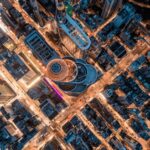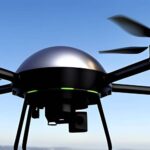
Aerial photography has evolved tremendously with the advent of drone technology, offering unique perspectives and breathtaking visuals.
One of the most advanced techniques in this field is HDR (High Dynamic Range) drone photography.
In this article, we will delve into the world of HDR drone photography, exploring what it is, why it matters, and the techniques to master it.
Understanding HDR Drone Photography
HDR photography is a technique that involves capturing multiple images of the same scene at different exposure levels and then merging them to create a single image with a wider dynamic range.
The goal is to ensure that both the brightest and darkest parts of the scene are properly exposed, resulting in a well-balanced and highly detailed photograph.
Why HDR Matters in Aerial Photography
Aerial photography often presents challenging lighting conditions, with stark contrasts between bright skies and shadowy landscapes. This is where HDR comes into play:
- Enhanced Dynamic Range: HDR techniques allow drone photographers to capture a broader range of tones, preserving details in both highlights and shadows. This results in images that appear more realistic and visually appealing.
- Balanced Exposure: In high-contrast scenes, traditional photographs may either overexpose the sky or underexpose the ground. HDR helps strike a balance, ensuring that both the sky and ground are properly exposed.
- Greater Image Quality: HDR images are known for their exceptional clarity, vibrant colors, and fine details. They provide a more immersive viewing experience and are ideal for showcasing landscapes, architecture, and natural scenery.
Mastering HDR Drone Photography
- Select the Right Equipment: To capture high-quality HDR images, invest in a drone camera with manual exposure settings, bracketing options, and a reliable gimbal for stabilization.
- Understand Bracketing: Bracketing is the foundation of HDR photography. It involves taking multiple shots of the same scene at varying exposure levels. Common bracketing settings include -2, 0, and +2 exposure values (EV) for a well-exposed image.
- Steady Flight: Stability is crucial for HDR photography. Ensure your drone is steady during the entire bracketing sequence. Use a tripod mode or employ a stable flying technique.
- Use a Remote Shutter: Avoid camera shake by using a remote shutter or a timed delay to capture the bracketed shots. This helps maintain the alignment of the images.
- Manual Mode: Switch to manual mode to have full control over exposure settings, including shutter speed, aperture, and ISO. Adjust these settings to achieve the desired exposure range.
- Post-Processing: After capturing the bracketed shots, use HDR software or editing tools like Adobe Lightroom or Photomatix to merge and tone-map the images. This process combines the best parts of each exposure to create the final HDR image.
- Avoid Overprocessing: While HDR can enhance images, it’s important not to overdo it. Strive for a natural look that retains details without making the image appear unrealistic.
Conclusion
HDR drone photography is a powerful technique that allows you to capture stunning aerial images with exceptional dynamic range and detail.
By understanding the principles of HDR, selecting the right equipment, and mastering the techniques, you can elevate your aerial photography skills and create captivating visuals that leave a lasting impression.
Embrace the world of HDR drone photography, and unlock a world of creative possibilities in the realm of aerial imaging.








